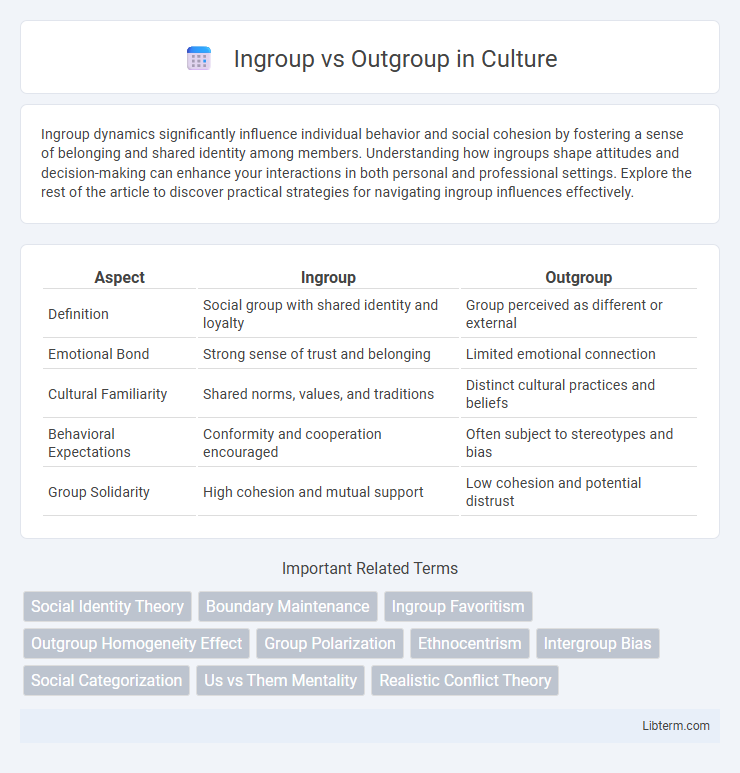Ingroup dynamics significantly influence individual behavior and social cohesion by fostering a sense of belonging and shared identity among members. Understanding how ingroups shape attitudes and decision-making can enhance your interactions in both personal and professional settings. Explore the rest of the article to discover practical strategies for navigating ingroup influences effectively.
Table of Comparison
| Aspect | Ingroup | Outgroup |
|---|---|---|
| Definition | Social group with shared identity and loyalty | Group perceived as different or external |
| Emotional Bond | Strong sense of trust and belonging | Limited emotional connection |
| Cultural Familiarity | Shared norms, values, and traditions | Distinct cultural practices and beliefs |
| Behavioral Expectations | Conformity and cooperation encouraged | Often subject to stereotypes and bias |
| Group Solidarity | High cohesion and mutual support | Low cohesion and potential distrust |
Introduction to Ingroup and Outgroup Dynamics
Ingroup and outgroup dynamics refer to how individuals categorize themselves and others into social groups, influencing attitudes and behaviors. Ingroup members share a sense of identity, loyalty, and common goals, while outgroup members are perceived as different or opposing. This division impacts social cohesion, bias formation, and intergroup relations, shaping conflict and cooperation patterns across various settings.
Defining Ingroup and Outgroup
Ingroup refers to a social group to which an individual feels they belong, characterized by shared identity, values, and experiences, fostering loyalty and cooperation among members. Outgroup denotes those outside the ingroup, often perceived as different or less familiar, which can lead to stereotyping and bias. Understanding the dynamics between ingroup and outgroup is crucial for analyzing social behavior, group conflict, and intergroup relations.
Psychological Foundations of Group Identity
Group identity forms through psychological processes such as social categorization, where individuals classify themselves and others into groups based on shared characteristics. Ingroup favoritism arises from a need for belonging and self-esteem, leading to preferential treatment of members within one's own group. Outgroup bias often results from perceived threats to group cohesion, reinforcing boundaries and heightening intergroup conflict.
Evolutionary Perspectives on Group Formation
Ingroup and outgroup dynamics are rooted in evolutionary mechanisms that enhanced survival through cooperation and resource competition. Early human ancestors formed tight ingroups to protect against external threats and increase reproductive success, while distinguishing outgroups facilitated vigilance against potential rivals. These evolutionary pressures shaped cognitive biases favoring ingroup loyalty and outgroup suspicion, fundamental in social identity and group cohesion theories.
Common Examples of Ingroup vs Outgroup in Society
Common examples of ingroup vs outgroup in society include sports fans supporting their favorite teams while viewing rival teams as outsiders, religious communities identifying members by shared beliefs and often perceiving non-members as outgroup, and workplace environments where employees align with their department or team, distinguishing themselves from others. These divisions shape social identity and influence group dynamics, affecting cooperation and conflict. Understanding ingroup and outgroup distinctions is crucial for addressing social biases and promoting inclusivity.
Effects of Ingroup Bias on Behavior
Ingroup bias significantly influences social behavior by fostering favoritism toward members of one's own group, leading to preferential treatment in resource allocation, trust, and cooperation. This bias often results in diminished empathy and increased stereotyping or discrimination against outgroup members, escalating intergroup conflict and social division. Psychological studies reveal that ingroup favoritism strengthens social identity and cohesion but undermines fairness and objectivity in decision-making across various contexts.
Consequences of Outgroup Stereotyping
Outgroup stereotyping often leads to prejudice, discrimination, and social exclusion, reinforcing negative biases and limiting intergroup cooperation. These stereotypes can cause misunderstandings and escalate conflicts between groups, damaging social cohesion and increasing intergroup hostility. Such consequences undermine efforts toward diversity, equity, and inclusion in communities and workplaces.
Ingroup-Outgroup Dynamics in the Workplace
Ingroup-outgroup dynamics in the workplace significantly impact team collaboration and organizational culture by fostering strong bonds within ingroups while often creating exclusion or bias against outgroups. These dynamics influence communication patterns, decision-making processes, and employee morale, potentially leading to in-group favoritism and out-group marginalization. Understanding and addressing these social divisions through inclusive leadership and diversity initiatives can enhance workplace cohesion and productivity.
Reducing Intergroup Tension and Promoting Inclusion
Reducing intergroup tension involves strategies such as fostering shared goals and encouraging positive intergroup contact, which promote empathy and cooperation between ingroups and outgroups. Implementing inclusive policies and diversity training in organizations enhances belonging and reduces biases, leading to more harmonious social environments. Emphasizing common identities and interdependence helps to break down stereotypical barriers, facilitating greater social cohesion and inclusion.
Conclusion: Moving Beyond Group Divisions
Overcoming ingroup versus outgroup divisions requires fostering empathy, promoting inclusive narratives, and encouraging shared goals that transcend social boundaries. Emphasizing common humanity diminishes prejudice and reduces intergroup conflict, facilitating cooperation and social cohesion. Sustainable progress depends on collective efforts to embrace diversity while prioritizing unity over division.
Ingroup Infographic

 libterm.com
libterm.com